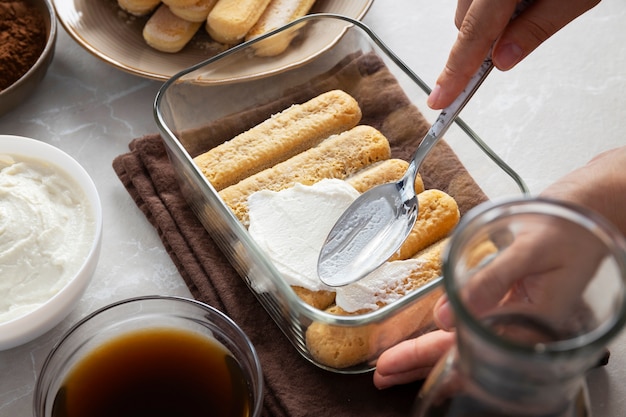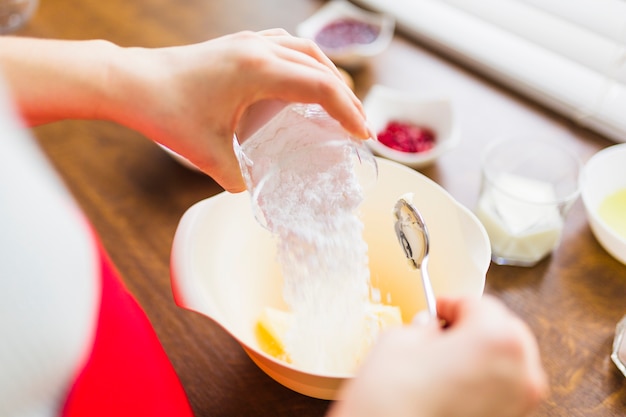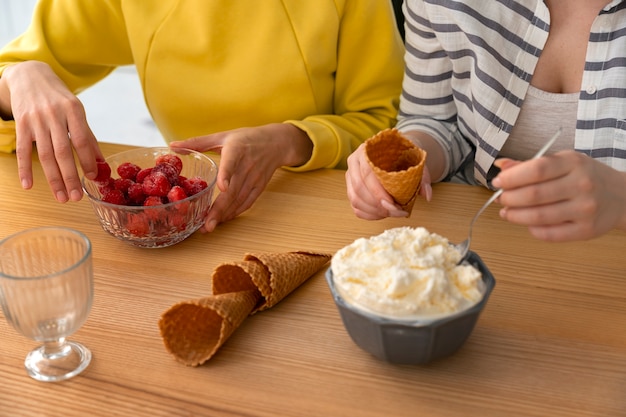(Part 1) The Bread: The Foundation of Your Creation

Finding the Perfect Bread: Beyond Just Any Loaf
You can use almost any bread, but some are better suited for bread pudding than others. My top picks are sturdy, crusty breads like sourdough or ciabatta. Their robust flavour stands up beautifully to the richness of the custard. But don't be afraid to venture beyond the obvious.
Here's a little cheat sheet to guide you:
- Crusty Wonders: Sourdough, ciabatta, baguettes – these breads add a delightful chewiness and a hint of tanginess that elevates the overall flavour.
- Sweet Delights: Brioche, challah, and even croissants provide a luxuriously soft texture and a subtly sweet note that pairs wonderfully with the custard.
- The "No-Nos": Avoid very fresh bread, as it won't soak up the custard properly, and you'll end up with a mushy mess. Soft, white bread like Wonderbread lacks the structural integrity to hold its own against the custard. And while not a deal breaker, breads with a lot of seeds can add a slightly chewy texture that might detract from the overall experience.
Getting the Bread Ready: From Stale to Sublime
Once you've got your bread, it's time to transform it from a loaf into the perfect building blocks for your bread pudding. The key here is to dry out the bread slightly, creating a texture that can absorb the custard without becoming soggy.- The oven method: Spread the bread cubes on a baking sheet and bake at 300°F (150°C) for about 10-15 minutes. This allows the bread to dry out gently, becoming slightly firm and a touch crispy on the edges.
- The Air Fryer Method: This is my personal favourite for its speed and efficiency. Toss the bread cubes in the air fryer for 5-7 minutes, until they develop a delightful crispy exterior.
- The Old-School Method: Simply leave the bread out on the counter for a day or two. It's the traditional way, allowing the bread to naturally become stale and absorb the custard beautifully.
For an added touch of flavour and texture, consider toasting the bread cubes before using them. The toasting process creates a subtly caramelised surface that adds a wonderful depth to the final dish.
(Part 2) The Custard: The Soul of Your Bread Pudding

The Essential Ingredients: A Recipe for Success
A basic custard recipe consists of a few key ingredients:
- Milk: Whole milk is my go-to choice for a rich, velvety custard. However, if you prefer a lighter option, feel free to use skimmed milk or even almond milk.
- Eggs: These are the backbone of the custard, providing structure and richness. The number of eggs you use will depend on the amount of bread you're using.
- Sugar: This adds sweetness and complements the flavours of the bread and other ingredients.
- Vanilla extract: A touch of vanilla adds warmth and depth to the custard, creating a comforting aroma and flavour.
Now, for the fun part: Feel free to experiment with different spices, extracts, and flavourings to add your own personal touch. Here are a few ideas to spark your creativity:
- Citrus: Add a burst of freshness with a squeeze of lemon or orange zest. It creates a bright and vibrant note that complements the richness of the custard.
- Spices: Cinnamon, nutmeg, cardamom, and ginger are all fantastic additions to bread pudding. Play around with different combinations to discover your favourite flavour profile.
- Booze: For an extra layer of complexity, add a splash of rum, brandy, or bourbon. The alcohol simmers away during baking, leaving behind a subtle warmth and a hint of sophistication.
Mastering the Technique: A Smooth and Silky Custard
Creating a perfect custard is a simple process, but a few key techniques ensure the smoothest, silkiest result:
- Whisk the eggs and sugar together first: This initial step helps to create a smooth and homogenous custard base.
- Gradually whisk in the hot milk: The key here is to temper the eggs. Gradually whisking the hot milk into the egg mixture prevents the eggs from scrambling, ensuring a smooth texture.
- Strain the custard: This essential step eliminates any pesky lumps that might form during the whisking process. Pass the custard through a fine-mesh sieve to ensure a luxuriously smooth texture.
(Part 3) The Baking: Bringing It All Together

Now comes the exciting part – the baking process! This is where the magic happens, as the bread and custard meld together to create a beautifully textured and flavourful bread pudding.
Preparing the Baking Dish: A Welcoming Home for Your Creation
Choose a baking dish that's large enough to comfortably hold your bread and custard mixture. Grease it well with butter or oil to prevent the pudding from sticking to the sides.
Layering the Bread and Custard: Two Methods, Endless Possibilities
There are two primary methods for layering the bread and custard, each with its own unique charm:
- The Classic Layer: This method is straightforward and reliable. Simply layer the bread cubes in the prepared baking dish, ensuring that they are evenly distributed. Pour the custard over the top, making sure all the bread is fully submerged.
- The Swirl Method: For a visually appealing presentation, try the swirl method. Place a layer of bread in the bottom of the baking dish. Pour half of the custard over the bread, followed by half of your chosen toppings (we'll delve into toppings shortly). Repeat the process, layering with the remaining bread, custard, and toppings.
Baking to Perfection: Patience is Key
Now comes the waiting game. Bake the bread pudding in a preheated oven at 350°F (175°C) for 45-60 minutes, or until it's set and golden brown. You'll know it's done when a toothpick inserted into the centre comes out clean.
(Part 4) The Toppings: Elevating the Experience
No bread pudding is complete without a generous helping of toppings. They add a burst of flavour, texture, and visual appeal, taking your bread pudding from ordinary to extraordinary.
Sweet and Luscious: For the Dessert Lover
If you're after a classic sweet treat, here are some toppings that will never fail to please:
- Whipped cream: A timeless classic that adds a touch of airy sweetness and complements the richness of the bread pudding.
- Vanilla ice cream: The ultimate pairing for warm bread pudding, offering a cool contrast and a delightful creamy texture.
- Caramel sauce: Drizzle it over the top for a touch of salty sweetness that creates a harmonious balance with the creamy custard.
- Chocolate sauce: This rich and decadent topping is always a crowd-pleaser, adding a luxurious and indulgent touch.
- Fresh fruit: Add a burst of freshness and vibrancy with berries, sliced bananas, or peaches. The fruit adds a bright counterpoint to the richness of the bread pudding.
- Powdered sugar: A light dusting of powdered sugar adds a touch of sweetness and elegance, creating a beautiful visual finish.
Savoury and Satisfying: A Twist on Tradition
For a more unexpected and satisfying experience, try these savoury toppings:
- Cheese: Grated cheddar, Parmesan, or crumbled goat cheese add a salty and tangy dimension that contrasts beautifully with the sweetness of the bread pudding.
- Nuts: Chopped pecans, walnuts, or almonds add a satisfying crunch and a nutty flavour that complements the richness of the dish.
- Bacon: crispy bacon bits are a surprisingly delicious and salty addition, providing a salty contrast to the sweetness of the pudding and a delightful textural element.
- Savoury sauces: Try a drizzle of maple syrup or a balsamic glaze for a touch of sweetness and acidity that balances the richness of the dish.
(Part 5) The Variations: Unleash Your Creativity
The beauty of bread pudding is its remarkable versatility. It's a blank canvas upon which you can create countless flavour combinations and variations to suit your taste buds and culinary preferences.
Flavoured Bread Puddings: A World of Possibilities
- Chocolate Bread Pudding: Use chocolate bread for the base, and add cocoa powder and a splash of coffee to the custard. Top with chocolate shavings and whipped cream for a truly decadent indulgence.
- Apple Bread Pudding: Add chopped apples to the custard and top with a cinnamon-sugar crumble for a comforting and heartwarming twist.
- pumpkin bread Pudding: Use pumpkin bread and add pumpkin spice to the custard for a warm and autumnal treat. Top with a dollop of whipped cream and a sprinkle of nutmeg.
- Lemon Bread Pudding: Add lemon zest and juice to the custard for a bright and refreshing flavour. Top with a drizzle of lemon curd or a sprinkle of powdered sugar for a touch of tartness and sweetness.
Sweet or Savoury? Breaking the Mould
Don't limit yourself to the sweet side of bread pudding! Explore the savoury realm with this delicious variation:
- Savoury Bread Pudding: Use crusty bread and add grated cheese, chopped herbs, and sauteed vegetables to the custard. Bake it like a regular bread pudding, but serve it alongside a simple salad or a light soup for a comforting and satisfying meal.
(Part 6) Tips and Tricks: Mastering the Art of Bread Pudding
Over the years, I've learned a few tricks of the trade that help ensure the perfect bread pudding every time. Here are some insider tips to elevate your baking game:
- Don't overmix the custard: Overmixing can lead to a tough and rubbery pudding. Gently whisk the custard until just combined, ensuring a smooth texture without overworking it.
- Let the bread pudding cool slightly before serving: This allows the flavours to develop and the pudding to set properly.
- Make it ahead of time: Bread pudding is even better the next day! It allows the flavours to meld and deepen, creating a more complex and delicious experience.
- Store leftovers in the refrigerator: Bread pudding can be stored in the refrigerator for up to 3 days. Reheat it in the oven or microwave before serving, enjoying its warm and comforting goodness.
(Part 7) Serving Suggestions: From Breakfast to Dessert
Bread pudding is a remarkably versatile dish that can be enjoyed at any time of day. Its warm, comforting nature makes it a perfect choice for breakfast, brunch, dessert, or even a light supper.
Here are a few serving suggestions to inspire your culinary creativity:
- Breakfast: Serve it warm with a side of fruit and a cup of coffee. It's a comforting and satisfying way to start your day.
- Brunch: Pair it with a mimosa or a Bloody Mary for a special occasion. It adds a touch of elegance and indulgence to your brunch spread.
- Dessert: Serve it warm with a scoop of vanilla ice cream or whipped cream. It's a classic and satisfying dessert that never fails to please.
- Supper: Serve it with a green salad or a light soup for a comforting and satisfying meal. It's a lighter and less heavy option for a simple and enjoyable supper.
(Part 8) The Nutritional Breakdown: Enjoying It Mindfully
While bread pudding is a delicious treat, it's also important to be mindful of its nutritional content. Here's a breakdown of the typical nutritional values per serving:
| Nutrient | Value |
|---|---|
| Calories | 300-400 |
| Fat | 15-20 grams |
| Carbohydrates | 40-50 grams |
| Protein | 5-10 grams |
Of course, the actual nutritional content will vary depending on the ingredients you use and the recipe you follow. For example, if you use a richer custard with more butter or cream, the calorie and fat content will be higher. Similarly, adding cheese or bacon to a savoury bread pudding will increase the protein and fat content.
The key is to enjoy bread pudding in moderation and to be aware of its nutritional content. You can balance it out with a lighter meal or a side of fresh fruit and vegetables.
(Part 9) FAQs: Your Bread Pudding Questions Answered
Let's address some of the most frequently asked questions about making bread pudding:
- Can I use day-old bread for bread pudding? Absolutely! In fact, it's highly recommended. Stale bread absorbs the custard better and prevents the pudding from becoming soggy.
- What if my bread is too dry? If you're using very stale bread, you may need to add a little extra milk to the custard to ensure it's moist enough.
- How do I know when my bread pudding is done? A toothpick inserted into the center of the bread pudding should come out clean. The pudding should also be set and golden brown on top.
- Can I make bread pudding ahead of time? Yes! In fact, it's even better the next day. You can make it a day or two in advance and store it in the refrigerator. Just reheat it in the oven or microwave before serving.
- What are some good variations for bread pudding? The possibilities are endless! You can use different types of bread, add various flavours to the custard, and experiment with different toppings. Get creative and have fun with it!
Well, there you have it! I hope this ultimate guide has inspired you to unleash your inner bread pudding maestro. Now get out there and create the most delicious bread pudding you've ever tasted! And don't forget to share your culinary creations – I love hearing about your experiences and seeing what incredible bread puddings you've conjured up. Happy baking!
Everyone is watching

How to Cook Frozen Lobster Tails Perfectly: A Step-by-Step Guide
RecipesLobster. Just the word conjures up images of lavish meals, special occasions, and a taste of luxury. But let's...

Pigs in a Blanket Cooking Time: How Long to Bake for Perfect Results
RecipesAh, pigs in a blanket. Just the name conjures up images of those delightful little parcels of crispy pastry en...

Pork Fillet Cooking Time: How Long to Cook It Perfectly
RecipesPork fillet, or tenderloin as it's sometimes called, is a real favourite in our house. It's so versatile, and...

The Ultimate Guide to Tender, Juicy Pulled Pork
RecipesRight, let's talk pulled pork. It's one of those dishes that just screams "comfort food," doesn't it? I mean...

The Ultimate Guide to Cooking Sweet Potatoes: From Roasting to Mashing
RecipesSweet potatoes. Just the name conjures up images of warm, comforting dishes, bursts of vibrant color, and a to...
